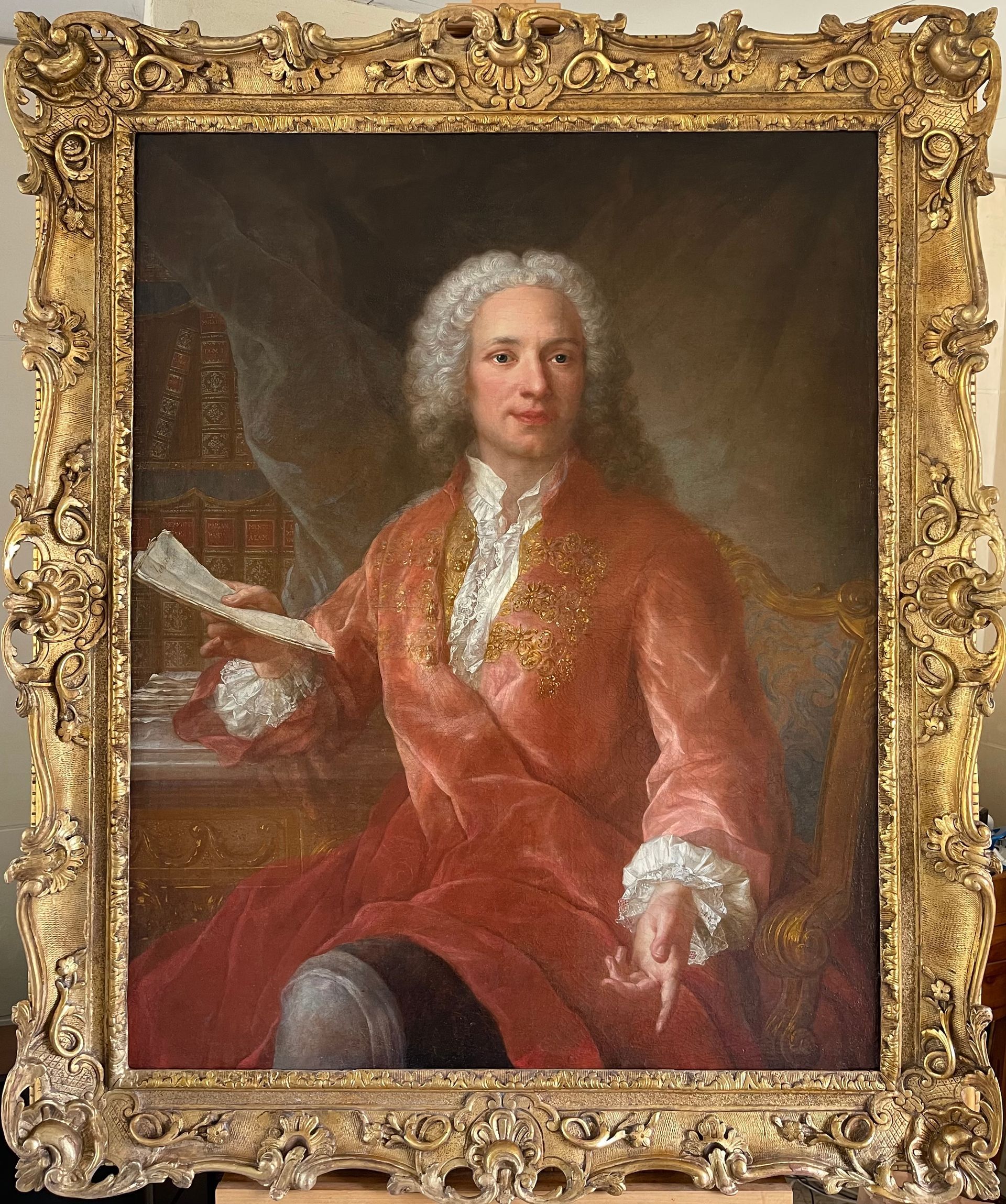
Nicolas LANCRET (Paris 1690 – 1743)
Circa 1730
Portrait of Charles de Fieux, Knight of Mouhy (Metz 1701-1784 Paris)
Worn signature on the letter: ‘La.c’
Oil on canvas (relined), 100.5 x 80 cm, in its original frame
The model's name inscribed on the reverse of the canvas and stretcher
PROVENANCE
- Nice, Private collection until July 2024
THE MODEL
The identity of the model is given on the reverse of the canvas and stretcher, inscriptions probably brought back by a restorer when the work was rebacked. It is confirmed by the 1737 engraving of the portrait of Charles de Fieux at the age of 36 (Latinville Pinx. Et Fessart Scul.) (fig.1). The print shows an older model, with a clearly recognisable nose, mouth and chin, but also a forehead, so there is no contradiction, as the inscription on the back of the painting corresponds to the correct identity of the model.
FIG.1.
Our painted portrait reveals a man younger than the model in the engraving, so we can estimate the age of Charles de Fieux at around thirty years old, giving an approximate date of execution of the painting around 1730.
Charles de Fieux, Chevalier de Mouhy (Metz 1701–1784 Paris), was a prolific novelist but also a journalist involved in Parisian literary life. He collaborated with Voltaire (1694–1778) and was involved in the publication of periodicals such as Le Répertoire which he founded in 1735, the year Lancret was appointed advisor to the Academy on March 24, 1735, a periodical containing Parisian anecdotes and literary criticism. In 1736, he entered the service of Voltaire, sending him "news by hand"[i] of Paris, supporting his plays, following his trials and, occasionally, acting as his front man. On April 25, 1741, the Chevalier de Mouhy was imprisoned in the Bastille for having published The Thousand and One Favors without permission[ii] (Court Tales, taken from ancient Gaulish, by the Queen of Navarre, 4 volumes), Mouhy will have operated a transgression there, slipping easily from gallantry to bawdiness, the author masking the erotic scenes with euphemism. His works include novels like The Peasant Woman reached And The Fly, as well as works on the history of theatre, such as Dramatic Tablets And Summary of the history of the Théâtre-Français.
Nicolas Lancret (1690–1743), meanwhile, was a renowned painter, a student of Antoine Watteau, a member of the Royal Academy of Painting and Sculpture, known for his gallant scenes and depictions of high society, a pictorial genre that blended elegance, sensuality, and theatrical staging. He painted works intended to adorn private residences, but also theaters and reception halls. His paintings participated in the frivolous and theatrical Rococo decor that dominated the visual culture of his time. In some of his works, Lancret did not simply allude to the theater: he directly depicted scenes of spectacle, such as open-air performances, dances, or plays. He thus documented a form of theatricalized life specific to the 18th-century aristocracy, with whom he enjoyed great popularity. The link between Nicolas Lancret and the theatre is essential to understanding his style and his era; like Watteau, he drew much of his inspiration from the Commedia dell'arte, an Italian theatrical form popular in the 17th and 18th centuries.
From then on, we can well imagine the link that could unite Nicolas Lancret and Charles de Fieux, the knight Mouhy will have written on the theater and the society of his time, while Lancret painted similar scenes. Their respective fields, literature and painting, culturally interconnected - they are also men of the same generation with Voltaire - must allow in time to find other information, Mouhy painted by Lancret has all the more meaning.
THE WORK
The signature of our portrait, present on the letter held by the model's right hand, has been correctly identified thanks to a scientific study[iii]. Under the digital microscope, a few letters made more distinct were enough to identify and partially reconstruct the name Lancret.
Evidence of portrait painting by Nicolas LANCRET is rare: a pair of small-format paintings (canvases, 41.3 x 33.3 cm & 39 x 31 cm), Portraits of Mr. and Mrs. Gaignat, is kept at the Fogg Art Museum, Harvard University.
The very free manner in which our work is painted, we notice a certain speed of execution, as evidenced by the repentance of the model's right hand initially resting on the edge of the console, but also another repentance of red drapes around the waist (fig.3 detail), is comparable to that of another work by the artist; for comparisons with the
Family portrait against a landscape background
by Lancret (canvas, 74.3 x 93.4 cm, Tajan, 18 Dec 2002, lot 40, former Wildenstein collection, Paris, 1924), painted with a similar technique, see the index finger of the man's left hand completely transparent under the drapery.
FIG.3. Detail.
The Self-portrait of the artist, canvas, 89 x 72 cm (Ader-Tajan sale, 7 Nov 1991, lot 76), probably painted in the years 1715/1720, deserves to be cited in this notice as it represents a beautiful testimony to the art of portraiture by Lancret. The model was famous, subsequently engraved by sculptors such as Ch. Courtry and M. Aubert.
[i] François Moureau, Directory of Handwritten News. Dictionary of the Clandestine Handwritten Press, Oxford, Voltaire Foundation, 1999.
[ii] Charles de Fieux de Mouhy[archive] on the Dictionary of Journalists (1600-1789)
[iii]
Art in Lab report from March 10, 2025
DETAIL PHOTOGRAPHS














